 Iran’s Attack on Israel
Iran’s Attack on Israel
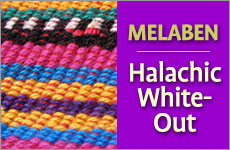

10 min read
Cleaning stains from various materials.
We are learning the 'Order of Garments,' which begins by shearing (Gozez) wool for the various fabrics hung in the Tabernacle.
Once our sheep has been shorn, we wind up with raw wool, called 'fleece'. In Rabbi Ribiat's words, the raw wool "is not a soft white fluffy material... In reality, [it] comes off as a dirty, matted blanket, packed together by an abundance of grease, sand, and numerous other impurities."1 Obviously, we need to clean up the fleece before it is ready to be processed into wool. This type of cleaning gives rise to the melacha of Melaben.
The word Melaben literally means "making something white." Within this category, the halacha includes cleaning any absorbent materials.
Let's understand what these terms mean.
The original Melaben material, as we've seen, is wool. Therefore, we learn that Melaben is limited to an absorbent type of material.
"Absorbent" means that if the material comes into contact with something wet, some of the moisture will remain within it.
In practical terms, there are two types of material:
1. Porous material – The laws of Melaben will apply to fabrics like cotton and canvas. So, most articles of clothing are subject to Melaben, as is carpet, many pieces of furniture, bedding, and other household items.
2. Non-porous material – Melaben does not apply to items like glass, stone, metal, wood, plastic, or laminated surfaces.
What about semi-porous material like leather, which does not absorb as readily as the others, but still allows moisture to penetrate? This is regarded as a sort of in-between category, and will be clarified as we go on.
To review: Melaben applies to porous materials like fabrics. The next step is to differentiate between the four types of 'dirt' substances:
Dirt #1: Non-absorbed – e.g. feathers, hair, lint. These may be removed from all materials, even by hand. That's because if, for example, a feather falls onto your coat, it does not at all become absorbed into the fabric; rather it is just sitting on top of the coat.
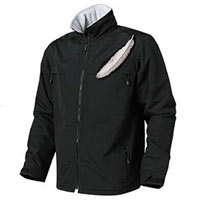
However, using a brush to remove lint or hairs is prohibited because of its resemblance to a weekday activity (uvda d'chol). It is permitted to brush off feathers or hair with a brush that is designated for use only on Shabbat ("Shabbat brush").
Dirt #2: Absorbed and Small – e.g. dust or powder. Removing this type of dirt on Shabbat depends on what type of 'material' has become dirty.
And if you have to walk around for the rest of Shabbat with a dust mark on your clothes? One rabbi refers to this as the "Badge of Courage" – i.e. it is a stain to be worn with pride, showing that one's commitment to halacha supersedes aesthetic concerns.
Dirt #3: Absorbed and Dry
• Porous material: As we just saw, Melaben applies only when you clean something by getting rid of the dirt embedded in the material, but not to items that are only on the surface.
So, if you drop some rice with sautéed mushrooms on your pants (for some reason, a frequent occurrence in my case), you can remove the pieces of food from your lap, but you can't scrape out the residue that has become embedded in your clothing.5
Furthermore, you may not apply any water to the stain. Certainly, soaking a stained or dirty item in water (shriyah6) is one of the main ways to clean an item, and this action is prohibited as Melaben. Even sprinkling water on a stain is not permitted.7
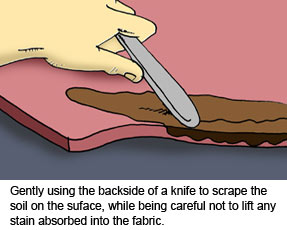
The only way to deal with the absorbed stain is: (1) to remove it with a shinui (change) – e.g. by gently using the backside of a spoon or knife, flicking one's fingers on the other side of the material, and (2) if a spot is left behind – i.e. you do not clean the absorbed part of the stain.8
• Non-porous material like plastic: These stains can be removed in any manner, even by applying water and rubbing off the stain.
The only restriction is not to rub the surface vigorously. This is part of a general restriction against excessive exertion on Shabbat.9
• In this case, the halacha makes a distinction with a semi-porous material like leather: One may either apply water to these absorbed dry stains without rubbing, or one may gently rub off the dirt without using water.10
Dirt #4: Absorbed and Wet – i.e. liquids such as wine, juice, soda, dirty water.
• Porous material: A typical Shabbat scenario is you're eating and some ketchup squirts on your shirt. Such wet stains may not be cleaned in any manner from cloth materials – neither by applying water, rubbing the stain, or squeezing it out.11
 • Non-porous material: Wet stains can be removed in any manner from glass or plastic material. For example, one may clean eyeglasses by first putting on water and then wiping it away.12
• Non-porous material: Wet stains can be removed in any manner from glass or plastic material. For example, one may clean eyeglasses by first putting on water and then wiping it away.12
There are some situations where what we normally refer to as "cleaning" is not considered Melaben – i.e. halachic cleaning.
For example, you spill some gravy and wipe it up with a rag. Since the rag is not becoming 'cleaned' by your action, but on the contrary, is becoming more soiled as a result, you are allowed to clean the spill in this way.13
However, the Sages prohibited soiling a material in such a way that might tempt you to clean it afterwards. Therefore, you could clean up the gravy spill with a rag, but not with a clean bath-towel.14
It is also advisable to avoid situations in which a material may get dirty. For example, when holding an infant on your lap, you should place an extra towel or diaper to protect your nice Shabbat clothes.15
Wiping a spill with a small towel or cloth is also not allowed, because the towel will become saturated, which is likely to lead to some liquid being squeezed out.16 As we've seen (in our lesson on Dosh), such squeezing (known as sechitah) is not allowed on Shabbat.17
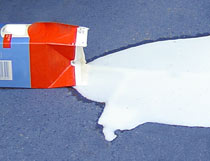
Consequently, one may not even touch or move a soaking wet cloth, as it is inevitable that water will be squeezed out in the process.18
Further, we cannot soak up liquids with something that one does not want to become wet, because you are likely to wind up squeezing out the liquid (which is an act of cleaning). It is permitted, however, to dry dishes with a special dish towel, even if the towel will get wet, since it is designed for this purpose.19
A hand towel – Similarly, it is okay to use a hand towel. However, if the towel becomes completely saturated with water, then any further use will lead to sechitah, and the towel can't be used any longer. A good example is when many people in a row are washing their hands for Netilat Yadayim.20 By the time you get toward the end of the line, you need to evaluate whether the towel can still be used.21
Getting caught in the rain – Since umbrellas can't be used on Shabbat (as we'll learn, G-d willing, in a future lesson), if it's raining and you are outside, you will get wet. When you get to your destination, you'll want to hang up your coat, and if you're at home, you might want to change into dry clothes. So far, so good.
However, when it comes to hanging up your wet clothes, the halacha provides a limitation: you should not hang the wet clothes in a place where you normally dry them, like a laundry room. This is because of the concept of Marit Ayin – it would seem to a casual observer that you've just washed the clothes and are now hanging them to dry.22 To avoid this mis-impression, the Sages required that we hang the clothes in an unusual way or place.23
Laundry hung before Shabbat may be left there during Shabbat, and can even be taken down on Shabbat – provided that: (1) it is needed for use on Shabbat, and (2) that it was not soaking wet at the beginning of Shabbat (because it would then be Muktzeh).24
Drying off a wet garment using heat – This is not an obvious halacha. Placing a wet raincoat or other garment near a source of heat, so that it will dry, is considered Melaben. The logic is that the coat's appearance will improve as it dries; thus, the drying is a form of 'cleansing'.25
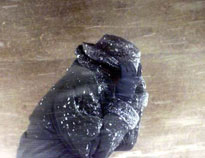
Brushing off dust and snow – Often, things like snow or dust will settle on your coat as you're walking outside on Shabbat. It is impossible to tell how well-absorbed the dust has become, so as a rule we are not allowed to brush the dust off (unless it is a large particle which is clearly on the surface only).26 As for snow, if it's on the surface it can be shaken off, but if it has melted into the coat, hat, or other item, then you just need to let it dry.
In practice, however, once you come indoors, some snow begins to melt, and if you shake off the coat, you may wind up squeezing out some of the moisture from the melted snow. This means that you need to blow or shake the snow off gently, so you'll only dislodge the stuff that is right on top and has not yet melted.27
